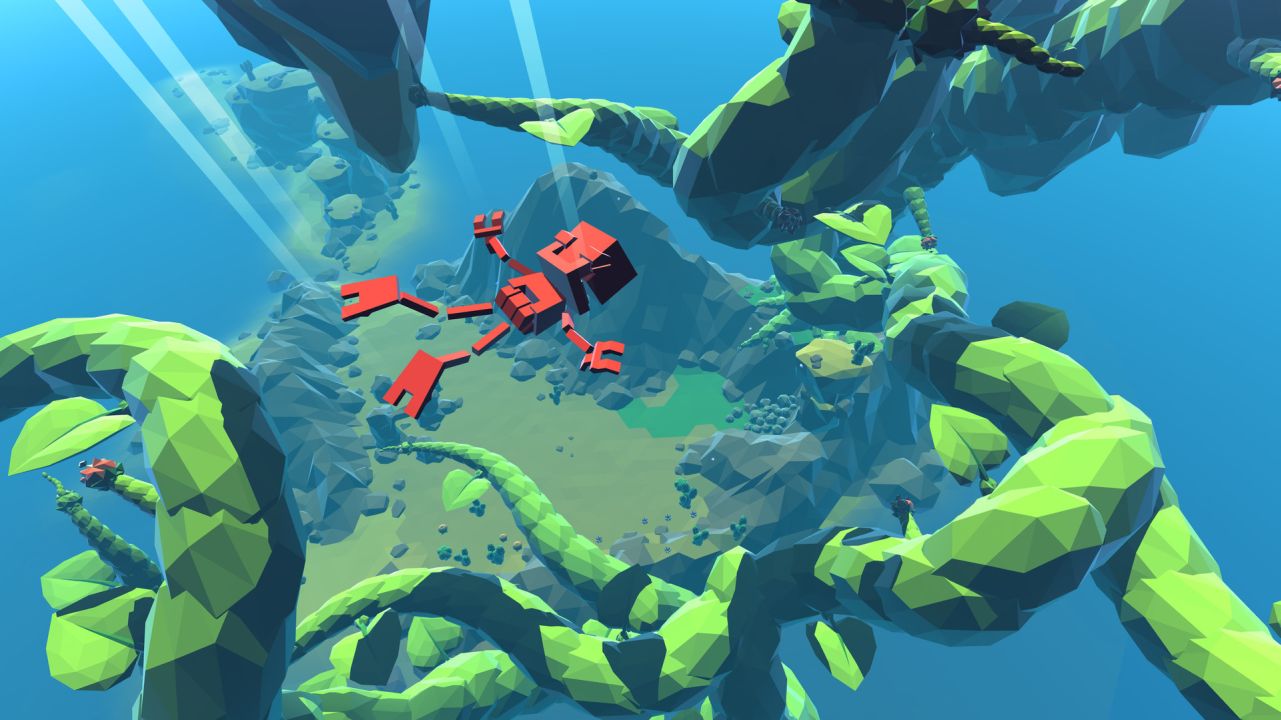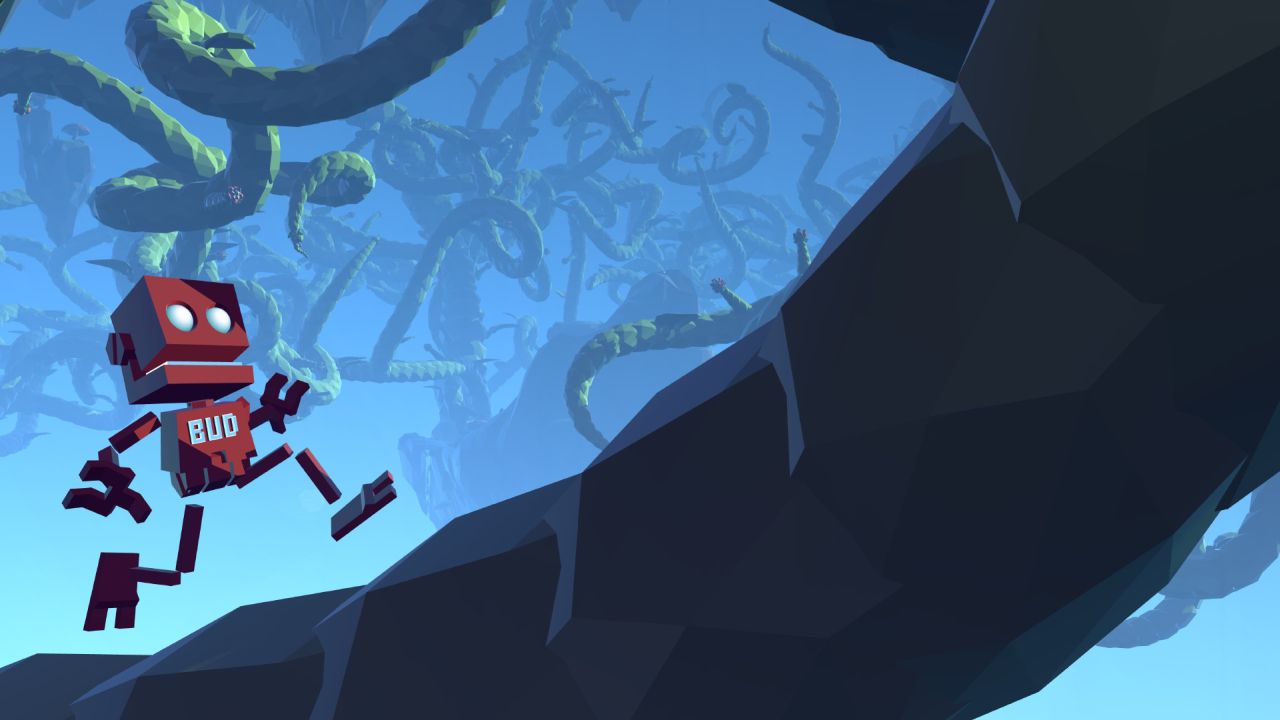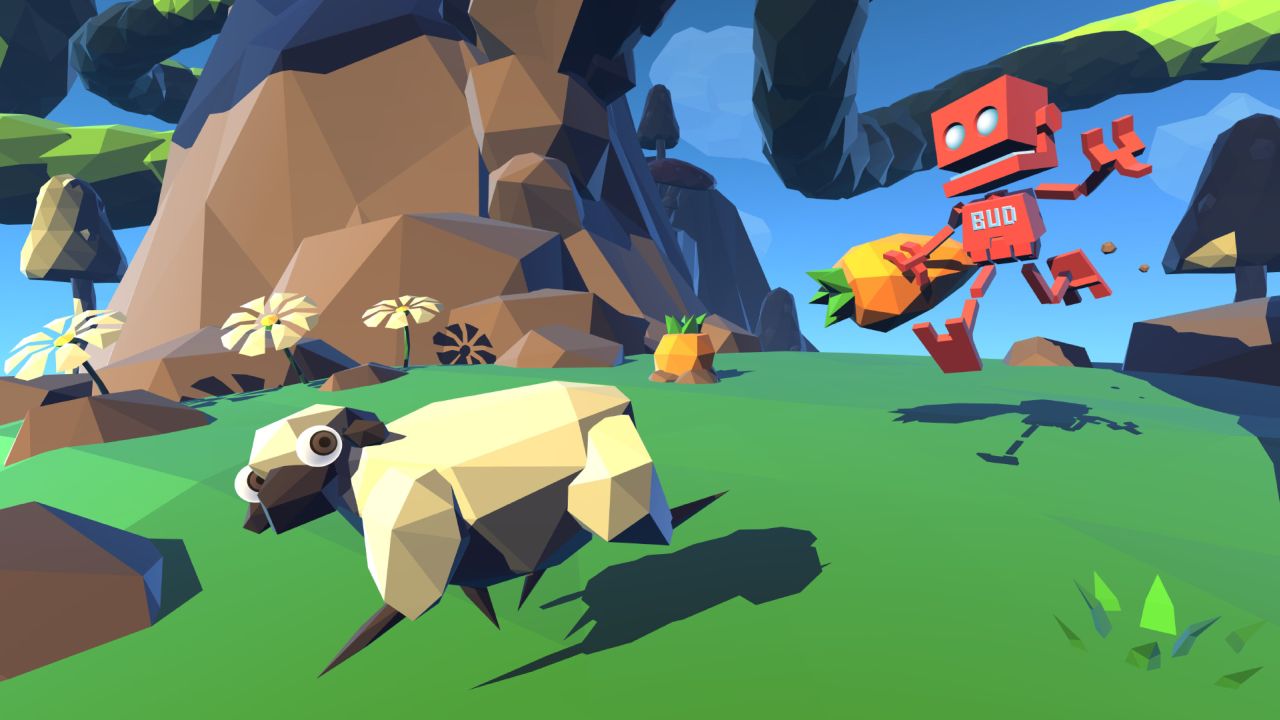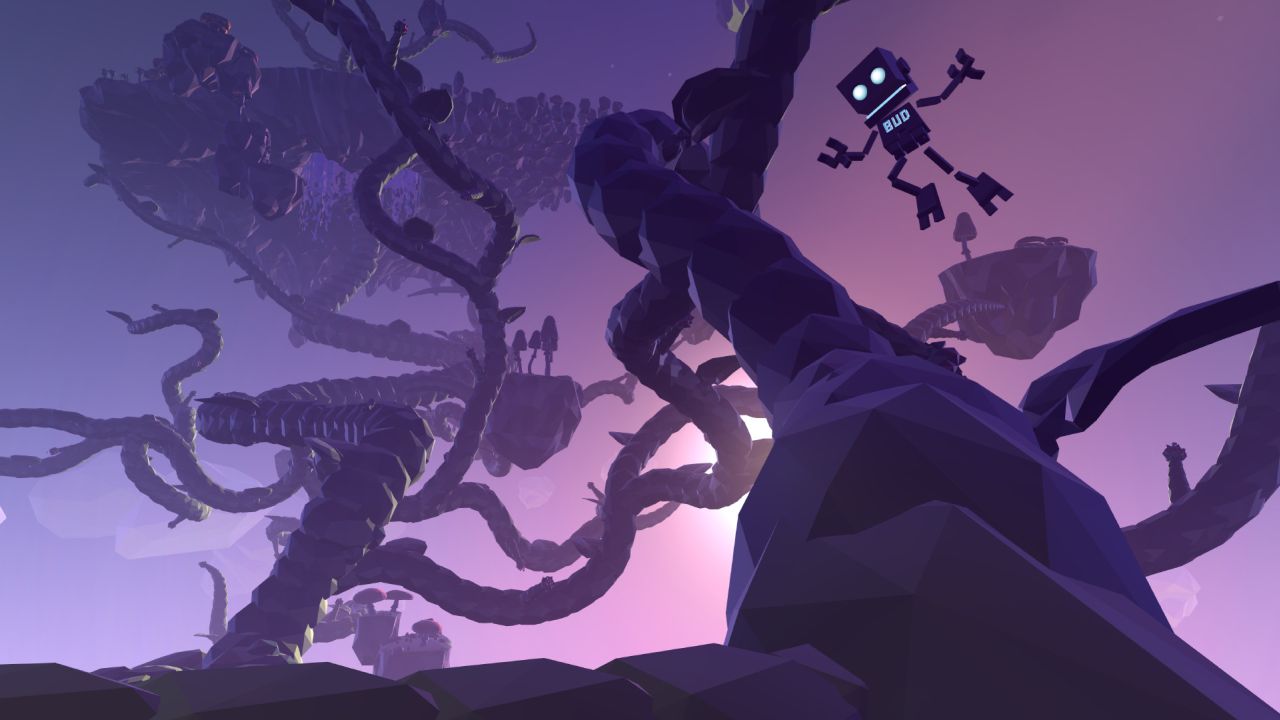Grow Home Review
Grow Home, Ubisoft, you're dr-- oh. Actually, carry on.
Well, I don't think any of us saw this one coming. You know Ubisoft? That multinational video game publisher that's earned itself a reputation for putting out huge, messy, bloated open-world games? Well, they just put out another open-world game. Shocking, I know, but this one was made in Unity by the people who did Watch_Dogs, lasts about an afternoon, costs ten bucks – to buy, not develop, although I wouldn't bet against it being true either way – and looks like the work of somebody who was cryonically frozen just after the release of Alone in the Dark 2 and still believes flat shading is the peak of what can be achieved with polygons. 'Surprising' doesn't do it justice; this is like waking up one morning to discover that Starbucks has set up a lemonade stall on your street corner, one staffed by rosy-cheeked children raising money for their dear ill grandmother. But is this a cynical game company trying to be the wolf among the indie sheep, or a beautiful spark of creative experimentation from one of the biggest publishers in the world?

It's disarmingly cute enough for the 'wolf among the sheep' option, if nothing else. You are a small, boxy robot called B.U.D. – that's Botanical Utility Droid, if memory serves correctly – that moves like it's being held together with old elastic bands and sounds like a 56k modem in a bucket of soap suds, two qualities that make it ideal for the task of terraforming an alien world. You've been dumped out of your spaceship by the mainframe – not maliciously, just as a wake-up call of sorts – and you have to work your way up by slowly growing a giant space vine that's important for some reason or another. You have to grow your way home, as it were. See, we totally have a legitimate reason for titling the game like that. No, we haven't heard of Fullbright, why do you ask?
Alright, so what's it do that's so interesting? Well, one pair of words jumps out at you from the Steam store blurb: 'procedurally-animated'. Instead of fixed animations, B.U.D. is kept on his feet by what I can only presume are a nightmarishly fiddly combination of physical rules and constraints, which are supposed to keep all his body parts in the right place but are kind of easygoing about their job, if you see what I mean. Initially this doesn't appear to have much of an effect, other than enabling you to stumble clumsily everywhere like Nico Bellic with a belly full of cheap gut-scouring vodka, but once you realise that this lets you dynamically move your hands as you please, the prospect of scaling that towering polygonal beanstalk suddenly piques a great deal more interest. I've always had a passing interest in games that force you to micromanage actions that would ordinarily be mapped to a single button – the likes of Octodad and Surgeon Simulator spring immediately to mind – because even though they're deliberately unintuitive and janky without exception, I like to believe they show us a tiny, imperfect glimpse of what games could be capable of when we throw away our peripherals and find a way to control them via spooky futuristic brain waves. Grow Home is kind of like that, but for clambering all over stuff. Like all such games, there's a brief, highly embarrassing learning period where you're scarcely capable of scaling a garden wall without having to stop halfway up and untangle all your extremities from one another, but pretty soon the placement of your hands becomes second nature; as intuitive as pressing a button, minus the usual mildly-discomforting knowledge that the game is doing all the important bits for you.

What I really love is how quickly that period of incompetence passes. Want to know what intuitive controls look like? You've struck gold. Left trigger for left hand, right trigger for right hand. Doesn't sound like much, I'm sure, but in a world where acrobatic protagonists just stick to walls until you have the common indecency to make them leap off and smash their smug faces into the ground, there's a special kind of connection to be felt with a character who only keeps his hands clutching the ledge as long as you, the player, keep your hands clutching the controller. Where Octodad used its unconventional controls as a unique, ever-present obstacle, Grow Home strives to use its unconventional controls to accomplish something that would be impossible any other way.
And what would dynamic climbing be without a dynamic environment to pit it against? More or less the same, probably, but that sounded good in my head so I'm sticking with it. It's the giant plant, you see. It sits as the centrepiece of the game: figuratively, as the one and only objective, and literally, as a gargantuan coiling, branching vine that dominates more and more of the landscape as it grows. Essentially, by grabbing hold and giving them a fond slap, you can coax the offshoots into growing explosively outwards, and if you're anything like me then your first instinct will be to try to get as many of them growing as possible just to see the Unity engine squirm under the pressure. Steer enough of them into glowing floating rocks - presumably full of whatever the outer space equivalent of top-dollar fertilizer is – and the main stalk will shoot onwards and upwards into the next area. Quite apart from making all the environments look like the Bed of Chaos's holiday photo album, it's a cleverly organic (no pun intended) way of visualising your progress, and I'd be lying if I said it wasn't hugely satisfying to take a few hundred steps back and appreciate your kilometre-tall alien bonsai as it corkscrews into the clouds. It may look fundamentally the same to everybody else's, but it's still yours.
Let's hope you're really blown away by that prospect, as there's not a whole lot else to do, I'm afraid, and of the stuff you can do, most of it is pretty typical of a sandbox in the sense that it's totally inconsequential. In the best traditions of frontier explorers throughout time and space, you can terrorise the local wildlife, uproot all the flora, set up machines to serve your own convenience – in this case, quick-travel teleporters – and last but not least, bleed the land of natural resources, by which I mean 'collect blue crystals'. Yep, that's how you know this is a Ubisoft game: somebody thought a hundred-piece scavenger hunt was just what this open world was in dire need of. Alright, as far as scavenger hunts go it's not too bad: it's not obligatory, you get a nice obvious sound cue as long as you're somewhere in a crystal's vicinity, tangible gameplay rewards at fairly-regular intervals – including a jetpack, which is one hundred percent guaranteed to improve any sandbox – and most importantly of all, it actually provides an incentive to explore every last inch of the alien planet – or at least, the vertical slice of it that's been made available to you.

Let me try to make “incentive to explore” sound less like the hollow game journo fluff it usually is. See, exploration in open world games is almost always carried out in the interests of finding stuff that's useful to gameplay. Whether it's Liberty City or Skyrim, what you're out for usually isn't so much the discovery of the world itself – exquisitely detailed though it be – as the bits of it specifically relevant to you, the player: collectibles, loot, shortcuts, the secret rocket launcher spawn, etcetera. Exploring for the sake of the environment often just reveals how utterly predictable it really is; a city is full of buildings, cars, and people, and you know for certain that you'll find those wherever you go. An alien planet with minimum gameplay distractions, on the other hand, is exactly the kind of place where you can explore in search of things to see, not things to stuff in your backpack. There are no real ground rules on what is and isn't congruous; you can poke your nose into every corner of the world, not really having any idea what you'll find, and it's this driving force, far more than that of your gardening responsibilities, that keeps you moving onwards and upwards.
Well, up to a point, that is. Around halfway up there's a sense that the game is running low on steam in terms of environment design: the beautiful floating islands, home to secret caves and bizarre wildlife, give way to a dozen or so uninteresting rocks spread across a space as large and featureless as gm_flatgrass. I have a sneaking suspicion that this was put there to give you a chance to really go nuts with the stalk and grow it into an impenetrable lime-green canopy – as you'll probably end up doing anyway – but it doesn't work, for the same reason you wouldn't set the new Grand Theft Auto on the surface of Pluto: your method of transport is only as interesting as the environments it interacts with. Grab an offshoot, point it at the nearest glowing energy rock, wish you could engage warp speed, rinse and repeat. Several acres of empty space, needless to say, aren't particularly exciting to interact with, and while I'm sure you could make an argument for it being nothing more than a canvas on which to demonstrate your space-gardening talents, the simple truth is that one patch of plant-ridden sky looks and plays pretty much like another – which is to say, like being inside a giant game of extraterrestrial Kerplunk.

I suppose my big problem with Grow Home isn't that it does something wrong so much as it doesn't do much of anything at all. Ubisoft's blog all but admits that this all started off as an experimental little curiosity with no real ambitions, and that's exactly what it feels like: a couple of unusual, clever ideas made sellable with the addition of a single objective and some arbitrary collectibles. I'm not going to go into “is this a game” territory here, because frankly I've never seen anybody argue that topic without producing a mile-high pile of unnecessary semantic garbage, but Grow Home is definitely pretty light on the ground when it comes to gameplay. Oh, but wait, once you grow your beanstalk all the way to the top, you get an all-new, once-in-a-lifetime, exclusive post-credits objective: another scavenger hunt, this time without even the thin justification of exploration. What a jip.
And yet, Grow Home gets a recommendation. No, it gets more than a recommendation: it gets my bated anticipation for those that follow in its wake. Even standing alone, it's a cute exploration game with unique, satisfying climbing mechanics, but far more significant is what it represents. I want more Grow Homes; I want giant multinational game developers to let their team members off the leash once in a while just to see what weird, experimental stuff they come up with. It's only healthy, you know.
Failing that, a new Assassin's Creed with these climbing mechanics would be a real hoot.
 Comments
Comments












